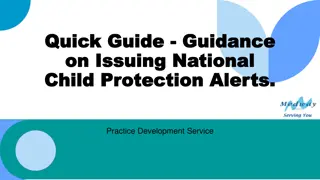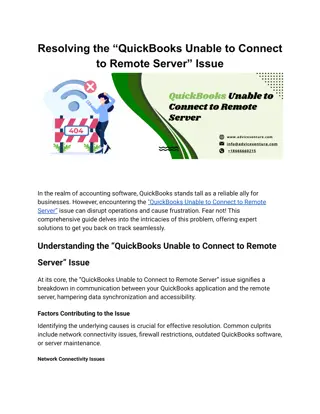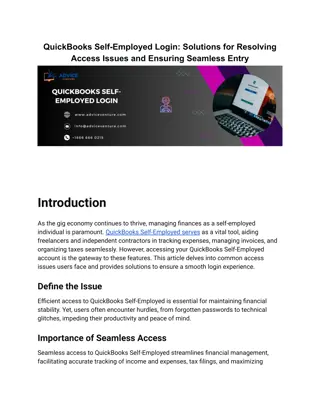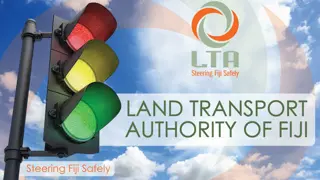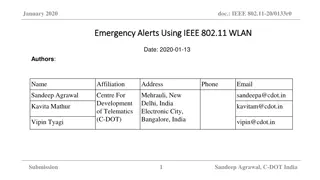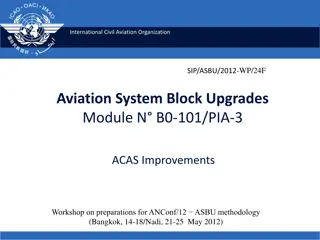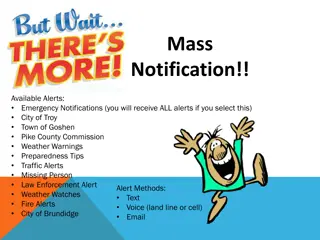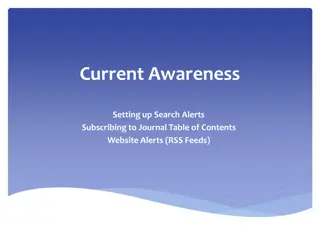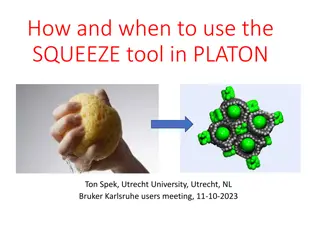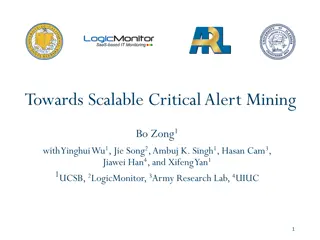
PLATON Tools for Resolving Cryptic checkCIF Alerts
A checkCIF report today, as part of the refereeing process for crystal structure papers, requires an IUCr/checkCIF report. It includes a PLATON/checkCIF report integrated into it, aiming at providing information on the data quality, refined model, and experimental procedures used. The report consists of compact ALERT messages that identify issues to be corrected or noted, with some being flagged as non-errors. These alerts, starting with PLATxyz, are created by PLATON and included in the original IUCr alerts set. IUCr/checkCIF, around for over 25 years, is essential for journals publishing crystal structure papers, following the CIF standard for data exchange. PLATON, a program with multiple tools, plays a significant role in ensuring crystal structure reports meet the required standards.
Download Presentation

Please find below an Image/Link to download the presentation.
The content on the website is provided AS IS for your information and personal use only. It may not be sold, licensed, or shared on other websites without obtaining consent from the author. If you encounter any issues during the download, it is possible that the publisher has removed the file from their server.
You are allowed to download the files provided on this website for personal or commercial use, subject to the condition that they are used lawfully. All files are the property of their respective owners.
The content on the website is provided AS IS for your information and personal use only. It may not be sold, licensed, or shared on other websites without obtaining consent from the author.
E N D
Presentation Transcript
2015 MACOSH Meeting Tampa OSHA Area Office PRESENTED BY: Les Grove Area Director Tampa Area Office
TAMPA AREA OFFICE CURRENT STAFFING SAFETY SPECIALISTS INDUSTRIAL HYGIENISTS COMPLIANCE ASSISTANCE SPECIALIST WB INVESTIGATORS ADMINISTRATIVE SUPPORT ASSISTANT AREA DIRECTOR AREA DIRECTOR TOTAL 15 9 1 2 3 3 1 34
Maritime Inspections Complaints Referrals Fatalities Site Specific Targeting (in the past) Regional Emphasis Program for Programmed Maritime Inspections
REP for Programmed Maritime Inspections - Scope Shipbuilding and repair Marine cargo handling Navigation services to shipping, port and harbor operations Other support activities for water transportation Port and harbor operations
REP for Programmed Maritime Inspections Boat building Marinas engaged in recreational boat repair located on or adjacent to navigable waterways
Scheduling lists for the REP List by Port Area list of port areas may be prepared by the Area Director List by Employer a list of all maritime service employers within the Area Office s jurisdiction may be prepared The method of selection is determined at the beginning of each fiscal year based on the type of maritime activities within the Area Office jurisdiction
Shipyard Inspection Referral (fall) Contractor was hired to remove insulation and clean a large sulfur tank in the cargo section of a barge at a shipyard
Shipyard Inspection At about 6:30am employees entered the tank to clean sulfur dust that had accumulated on top of the tank and on metal beams and various structural pieces
Shipyard Inspection Three employees were working in an approximately 4 foot high crawl/crouch space between the top of the sulfur tank and the bottom of the top deck of the barge The foreman was sweeping the sulfur from the top of the tank while two employees used spray bottles of water and rags to clean the sulfur off of the surfaces
Incident At approximately 7am, an employee was working at the tapered section of the tank, with his back to the edge and moving backwards when he lost his footing at the edge and fell over. He landed on a catwalk 17 feet below, bounced off and fell the remaining 10- 12 feet to the surface below.
Findings The employer had fall protection equipment on top of the tank, but it wasn t used Their fall protection policy was verbal; if you have to reach over the edge, you wear a harness and tie off to a frame
Findings The employer did not assess the space layout and did not know the tank was tapered at one end, increasing the gap from 2 feet to 2.75 feet where the employee fell The foreman stated that he would have required fall protection if he knew the tank was tapered at one end
Serious Citation 1, Item 1 $4,900 penalty 1915.77(c): Employees were not protected by safety belts and lifelines while working aloft at elevations more than 5 feet above a solid surface: Employees were exposed to a fall hazard of 17-27 feet while cleaning sulfur dust from elevated surfaces
Serious Citation 1, Item 2 $4,200 penalty 1915.152(a): The employer did not provide and ensure that each affected employee used appropriate PPE for head protection Employees working under the ship deck in a 4 foot crawl/crouch space did not wear head protection (they didn t have a chin strap and they kept falling off)
Case Settled The employer entered into an Informal Settlement Agreement, accepting the violations with a penalty reduction and penalty payment plan
Boat Builder Inspection Inspection conducted under the Site Specific Targeting (SST) inspection plan Assigned compliance officer was a CSP who had lateralled into a vacant Industrial Hygienist position A comprehensive safety inspection was conducted and he also addressed the health items that were identified
Exposure Monitoring Noise monitoring was conducted for grinding operations Screen sampling was conducted for styrene in the lamination building Exposure monitoring was conducted in the lamination building for an employee who mixed and poured foam that contained methylene bisphenyl isocyanate into a mold
Exposure Monitoring Exposure monitoring was conducted for 1,6 hexamethylene diisocyanate homopolymer and hexamethylene diisocyanate in the varnish department during the spray application of a sealer Wipe samples were taken in the varnish building for isocyanates Wipe samples were taken in the new assembly building where lead ballasts were sanded
Citation Issued $44,100.00 5(a)(1) - Yale 2-ton hoist was missing the hook safety latch and a second hoist had not received an annual periodic inspection
Violations 1910.37 - Exit door not marked and sign not posted for direction of travel to the nearest exit 1910.95 - Grinder operator was exposed to noise level of 97.9dBA; an annual audiogram had not been obtained for 7 years; and annual training had not been conducted for years 1910.132 - Painter spraying liquids containing isocyanates had exposed neck and facial skin
Violations 1910.134 - Respirator program administrator was not qualified (e.g., he conducted fit testing incorrectly), a respiratory hazard assessment was not conducted, the medical evaluation did not contain all of the required information and Appendix D was not provided 1910.147 - Lock-out/Tag-out: Affected employees were not trained and training for authorized employees was not documented
Violations 1910.157 - Employees expected to use fire extinguishers had not been trained 1910.213(m)(1) - Table router had exposed blades 3/8 of an inch above the table 1910.213(p)(4) - Horizontal belt sander had an exposed nip point on the back side 1910.1025(d)(2) - Lead hazard assessment was not conducted for the ballast work 1910.1025(h)(1) Portable sander handle and a shelf had accumulations of lead
Violations 1910.1025(l) - Employees grinding lead ballasts had not been informed of the content of Appendices A and B of the lead standard 1910.1200(g) - Safety Data Sheets were not maintained for the Urethane Sealer Catalyst that contained isocyantes 1910.1200(h) - The painter and foamer who sprayed sealer and mixed and poured foam containing isocyantes had not received hazard communication training
Violations 1910.107 - The manometer for the spray booth wasn t operable 1910.178 - An evaluation of each PIT operator s performance had not been conducted at least once every three years (it had been 7 years) 1910.305(g)(1) - Electrical cords for a Dayton hoist were taped to an extension cord, effectively making it one long cord 1910.305(g)(2) - An extension cord was spliced with masking tape wrapped around it
Hazard Alert Letter A HAL letter was sent to the employer regarding employee exposures to 1,6 - hexamethylene diisocyanate homopolymers and hexamethylene diisocyante recommending that they voluntarily take the necessary steps to materially reduce or eliminate their employees exposures
Case Settled The employer entered into an Informal Settlement Agreement, accepting the violations with a penalty reduction and penalty payment plan They eliminated the use of isocyanates


